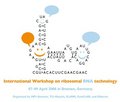Seitenpfad:
- Presse
- Pressemeldungen 2008
- Workshop über Molekulare Marker: Ribosomale RNA
Workshop über Molekulare Marker: Ribosomale RNA
Weitere Informationen zum Workshop finden Sie hier.
Short Summary about the
International workshop on ribosomal RNA Technology
7-9 April 2008, Max Planck Institute for Marine Microbiology, Bremen, Germany
Thirty years have passed since Carl Woese suggested three primary kingdoms based on the phylogenetic analysis of the ribosomal RNA genes. Despite ongoing discussions about the validity of the concept, the introduction of the ribosomal RNA as a universal molecular marker has influenced the self conception of microbiology to its roots. Adopted by many researchers worldwide the ribosomal RNA has become the “gold-standard” for molecular taxonomy, diversity analysis and the identification of microorganisms.
The more than 700,000 rRNA sequences in the public databases constitute an unprecedented hallmark of the richness of microbial biodiversity on earth. Nevertheless, from the ongoing genomic and metagenomic studies it is evident that we might have seen only the tip of the iceberg so far. The workshop was intended to sum up the current status and think about how to best proceed with this rich harvest from a technological and biological point of view. Central points that have been addressed were:
1.What kind of technology is needed to help biologists to deal with the deluge of data?
2.Which kinds and quality of data can be expected that need to be organized, stored and analysed?
3.How can the rRNA help to answer burning questions in biology?
To move on with these issues 26 experts from Europe and the US presented their results and opinions about burning topics in the field of rRNA technology. They were complemented by more than 110 participants selected from nearly 170 applications received from 25 countries all around the world.
The workshop has crossed boundaries by bringing together computer scientists, bioinformaticians, geologists, biologists and ecologists. Starting with introducing the main rRNA database providers like RDP II or SILVA, participants were moved into the field of phylogenetic inference and ecological data analysis. Finally, the question “Is everything everywhere?” and “How can we determine the biogeography of microorganisms?” rounded up the first day. The second day started with an overview about the “state of the art” technologies for the qualitative and quantitative determination of diversity linked to potential functions. It was backed up with information about microscopy, imaging and probe synthesis from commercial partners. In the last session, reaching out to the third day, microbial ecologist presented their view on the orchestral interplay of microbes in their natural environments. Questions about “phylotypes and ecotypes” and “How do the community structures in various habitats compare?” where raised and addressed by world leading experts.
The workshop was a joined collaborative effort of the Max Planck Institute in Bremen and the Ribocon GmbH Bremen, the Technical University Munich, the International Census of Marine Microbes (ICoMM) and the European Census of Marine Life (EuroCoML). The workshop was further sponsored by the companies Operon and BioCat.
Further information can be found at http://www.arb-silva.de/rrna-workshop/
International workshop on ribosomal RNA Technology
7-9 April 2008, Max Planck Institute for Marine Microbiology, Bremen, Germany
Thirty years have passed since Carl Woese suggested three primary kingdoms based on the phylogenetic analysis of the ribosomal RNA genes. Despite ongoing discussions about the validity of the concept, the introduction of the ribosomal RNA as a universal molecular marker has influenced the self conception of microbiology to its roots. Adopted by many researchers worldwide the ribosomal RNA has become the “gold-standard” for molecular taxonomy, diversity analysis and the identification of microorganisms.
The more than 700,000 rRNA sequences in the public databases constitute an unprecedented hallmark of the richness of microbial biodiversity on earth. Nevertheless, from the ongoing genomic and metagenomic studies it is evident that we might have seen only the tip of the iceberg so far. The workshop was intended to sum up the current status and think about how to best proceed with this rich harvest from a technological and biological point of view. Central points that have been addressed were:
1.What kind of technology is needed to help biologists to deal with the deluge of data?
2.Which kinds and quality of data can be expected that need to be organized, stored and analysed?
3.How can the rRNA help to answer burning questions in biology?
To move on with these issues 26 experts from Europe and the US presented their results and opinions about burning topics in the field of rRNA technology. They were complemented by more than 110 participants selected from nearly 170 applications received from 25 countries all around the world.
The workshop has crossed boundaries by bringing together computer scientists, bioinformaticians, geologists, biologists and ecologists. Starting with introducing the main rRNA database providers like RDP II or SILVA, participants were moved into the field of phylogenetic inference and ecological data analysis. Finally, the question “Is everything everywhere?” and “How can we determine the biogeography of microorganisms?” rounded up the first day. The second day started with an overview about the “state of the art” technologies for the qualitative and quantitative determination of diversity linked to potential functions. It was backed up with information about microscopy, imaging and probe synthesis from commercial partners. In the last session, reaching out to the third day, microbial ecologist presented their view on the orchestral interplay of microbes in their natural environments. Questions about “phylotypes and ecotypes” and “How do the community structures in various habitats compare?” where raised and addressed by world leading experts.
The workshop was a joined collaborative effort of the Max Planck Institute in Bremen and the Ribocon GmbH Bremen, the Technical University Munich, the International Census of Marine Microbes (ICoMM) and the European Census of Marine Life (EuroCoML). The workshop was further sponsored by the companies Operon and BioCat.
Further information can be found at http://www.arb-silva.de/rrna-workshop/





